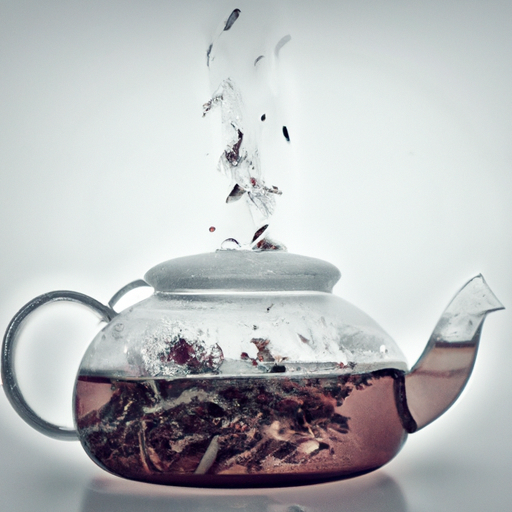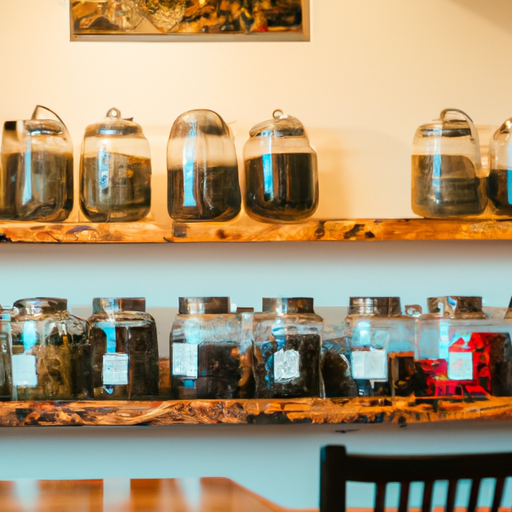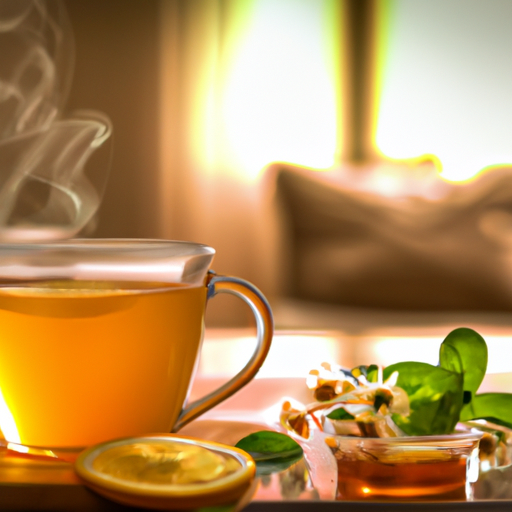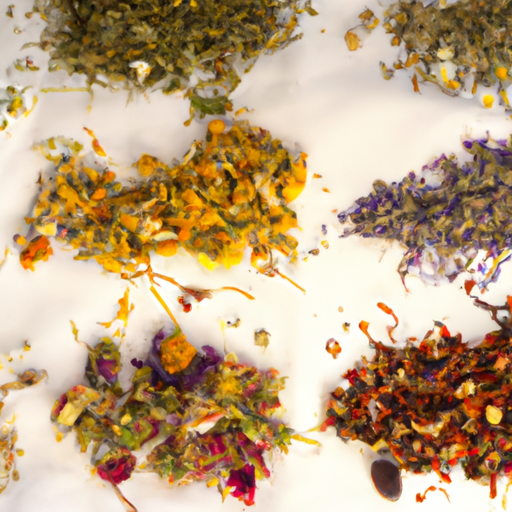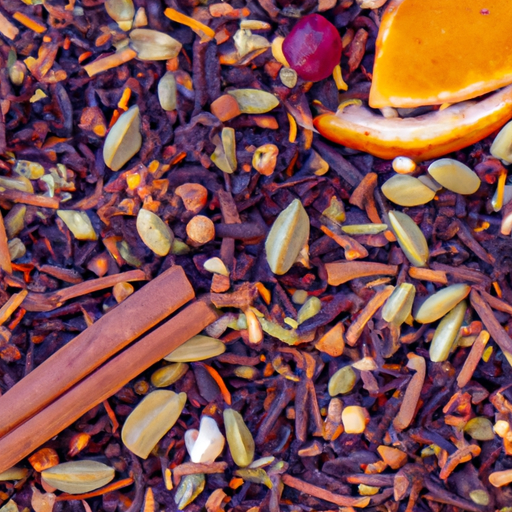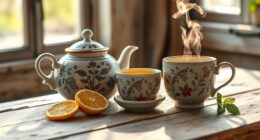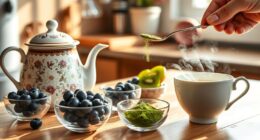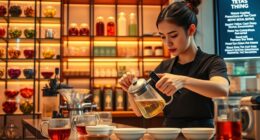Brewing herbal tea is akin to discovering a trove of flavors and health perks. It requires finesse in timing and temperature, with each moment being crucial. Being a tea lover, I’ve dedicated numerous hours to refining my brewing method, uncovering the optimal harmony that enhances the essence of every herb.
In this article, I’ll share my knowledge and experience on how long you can steep herbal tea to achieve the most exquisite taste and maximum health benefits.
From chamomile to peppermint, each herb has its own unique steeping time that allows its flavors and properties to fully infuse into the hot water. But don’t worry, I’ll guide you through the process, so you never have to guess again.
We’ll also explore the art of enhancing flavor through various steeping techniques and the importance of avoiding oversteeping.
Whether you’re a tea connoisseur or just starting your herbal tea journey, this article will equip you with the essential knowledge to create the perfect cup of herbal tea every time. So, grab your favorite mug, and let’s dive into the world of herbal tea steeping.
Key Takeaways
- Steeping herbal tea for too long can result in bitterness
- Different herbal teas have unique steeping times and water temperature requirements
- Experimenting with steeping times can enhance flavor and aroma
- Adjusting steeping time allows for flavor customization
Understanding Herbal Tea Steeping Times
Discover the perfect steeping time for your favorite herbal tea and unleash a burst of soothing flavors that’ll leave you feeling blissfully relaxed.
When it comes to herbal tea, understanding the optimal steeping time is essential for achieving the best taste and aroma. Experimenting with water temperature is a key factor in this process.
Different herbal tea blends require different water temperatures to extract their full potential. For delicate herbal teas like chamomile or lavender, a lower water temperature of around 200°F is ideal. Stronger blends like peppermint or ginger can handle higher temperatures of 212°F.
By understanding the characteristics of your herbal tea blend and experimenting with water temperature, you can find the perfect steeping time that brings out the flavors and aromas you desire.
Transitioning into the subsequent section, let’s now explore the art of experimenting with steeping times to further enhance your herbal tea experience.
Experimenting with Steeping Times
When it comes to achieving the desired flavor profiles in herbal tea, adjusting the steeping time is crucial.
As a tea enthusiast, I’ve found that experimenting with different steeping times can make a significant difference in taste and aroma.
By trying various steeping times and taking note of the differences, I’ve been able to find the perfect balance that suits my personal preferences.
How to adjust steeping time to achieve desired flavor profiles
To truly unlock the full potential of your herbal tea, you’ll need to become a brewing maestro. Skillfully adjusting the steeping time is the key to achieving flavor profiles that will make your taste buds dance with ecstasy!
Adjusting infusion time allows for flavor customization in herbal teas. The longer you steep, the stronger and more intense the flavors become. However, be cautious not to oversteep, as it can lead to bitterness. It’s a delicate balance that requires some experimentation.
Try steeping your herbal tea for different durations and note the differences in taste and aroma. You may find that some teas reach their peak at a shorter steeping time, while others require a longer infusion for the flavors to fully develop. These nuances in steeping time can make a world of difference in your tea-drinking experience.
So, let’s dive in and explore the wonderful world of herbal tea flavors!
Trying different steeping times and noting the differences in taste and aroma
By experimenting with varying infusion times, one can discern a plethora of subtle nuances in the flavors and aromas of their favorite herbal brews. Adjusting steeping time is a crucial factor in achieving the desired flavor profiles of herbal teas.
I’ve found that longer steeping times can bring out deeper, more complex flavors and aromas in the tea. For example, a longer steeping time for chamomile tea can enhance its soothing and calming properties. Similarly, steeping herbal blends like lavender and mint for an extended period can intensify their refreshing and invigorating qualities.
The benefits of longer steeping extend beyond flavor alone, as it can also maximize the release of beneficial compounds and antioxidants in the tea. However, it’s important to note that steeping herbal teas for too long can result in a bitter taste.
Transitioning into the subsequent section about maximizing health benefits, it’s crucial to find the perfect balance in steeping times to enjoy both the flavors and the potential health benefits of herbal teas.
Maximizing Health Benefits
In order to optimize the health benefits, it’s advisable to steep herbal tea for an extended period of time. By adjusting the steeping time, you can unlock the full potential of the tea’s medicinal properties. Here are four important things to consider when steeping herbal tea for maximum health benefits:
-
Choose the right herbal tea: Different herbal teas offer different health benefits. For example, chamomile tea can help with relaxation and sleep, while ginger tea aids digestion and boosts immunity.
-
Use hot water: Boiling water is ideal for steeping herbal teas as it helps extract the beneficial compounds effectively.
-
Steep for longer: The longer you steep, the more time the herbs have to release their beneficial properties into the water. Generally, steeping for 10-15 minutes is recommended.
-
Cover your cup: Covering your cup while steeping helps retain the volatile compounds, ensuring you receive the full health benefits.
By following these guidelines, you can maximize the health benefits of herbal tea and enjoy its soothing effects. However, it’s important to avoid oversteeping, as it can lead to a bitter taste and diminish the tea’s positive effects.
Avoiding Oversteeping
Steeping herbal tea for too long can ruin its delicate flavors and leave a bitter taste. To avoid bitterness, it’s important to adjust the steeping time based on the specific type of herbal tea you’re brewing. Some herbal teas, like chamomile or mint, require a shorter steeping time of around 5 minutes. Others, such as hibiscus or ginger, may need a longer steeping time of up to 10 minutes to fully release their flavors.
It’s always a good idea to follow the brewing instructions provided on the packaging for optimal results. By adjusting the steeping time accordingly, you can savor a perfectly balanced cup of herbal tea, free from any unpleasant bitterness.
Moving forward, let’s explore how to enhance the flavor of herbal tea using various steeping techniques.
Enhancing Flavor with Steeping Techniques
Get ready to take your cup of herbal tea to new heights by infusing it with flavor-enhancing techniques that’ll make your taste buds sing with delight.
Here are some tips for maximizing infusion and enhancing aroma:
- Crush and bruise the herbs before steeping to release their natural oils and flavors.
- Use hot water, but not boiling, to prevent scorching the delicate herbs.
- Steep for the recommended time, usually 5-7 minutes, to extract the full flavor without oversteeping.
- Experiment with different steeping times to find your preferred intensity.
By following these techniques, you can create a more flavorful and aromatic cup of herbal tea. Now that you know how to enhance the flavor, let’s move on to the next section about storing and reusing herbal tea.
Storing and Reusing Herbal Tea
Proper storage methods are essential for maintaining the freshness and flavor of herbal tea. I’ve found that storing herbal tea in airtight containers, away from light and moisture, helps to preserve its taste and aroma.
Additionally, reusing herbal tea leaves for multiple infusions can maximize their potential, allowing for a more economical and sustainable tea-drinking experience.
Proper storage methods to maintain freshness and flavor
To keep your herbal tea tasting its best, make sure you store it correctly. Proper storage methods are essential for maximizing shelf life and preventing flavor degradation.
First, always store your herbal tea in an airtight container to protect it from moisture, light, and air. This will help maintain its freshness and flavor for a longer period.
Additionally, store your herbal tea in a cool and dark place, away from direct sunlight and heat sources. Avoid storing it in the refrigerator, as the fluctuating temperatures can affect its taste.
Lastly, try to use your herbal tea within six to twelve months of purchase for the best flavor. By following these storage guidelines, you can ensure that your herbal tea remains delicious and enjoyable for as long as possible.
Now, let’s move on to reusing herbal tea leaves for multiple infusions and maximizing their potential.
Reusing herbal tea leaves for multiple infusions and maximizing their potential
Unlock the full potential of your brew by reusing those fragrant leaves for multiple infusions and watch your tea experience soar to new heights. Reusing tea leaves is a great way to maximize their flavor and get the most out of your herbal tea. By using different steeping techniques, you can uncover new layers of taste and complexity. Here’s a table outlining a few techniques you can try:
| Technique | Description |
|---|---|
| Steep and Pour | Steep the leaves for the recommended time, then pour and enjoy. |
| Cold Brew | Steep the leaves in cold water overnight for a refreshing iced tea. |
| Double Steep | Steep the leaves twice, using shorter steeping times each time. |
| Gongfu Infusion | Use a small teapot and multiple short infusions for a concentrated brew. |
| Grandpa Style | Steep the leaves in a mug and let them steep as you drink. |
By reusing tea leaves and experimenting with different techniques, you can discover new flavors and aromas in your herbal tea. Now, let’s move on to some tips for a perfect cup of herbal tea.
Tips for a Perfect Cup of Herbal Tea
When it comes to preparing a perfect cup of herbal tea, there are a few key points to keep in mind. First, make sure to use water at the optimal temperature for steeping, usually around 200°F.
Secondly, choose the right teaware that can retain heat and allow for proper infusion.
Lastly, don’t be afraid to experiment with different steeping times and techniques to find your ideal flavor profile.
Preparing the water temperature and teaware for optimal steeping
For the best flavor extraction, it’s important to use the right water temperature and teaware when steeping herbal tea. The water temperature plays a crucial role in bringing out the unique flavors and aromas of the herbs. Different herbs require different water temperatures, so it’s essential to know the ideal temperature for your specific herbal blend.
Generally, a temperature between 200-212°F (93-100°C) is suitable for most herbal teas.
As for teaware, choose a vessel that allows enough space for the herbs to expand and release their flavors. A ceramic or glass teapot with an infuser is an excellent option. The material should be non-reactive to ensure the purity of the tea.
With the right water temperature and teaware, you’re ready to experiment with different steeping times and techniques to find your perfect cup.
Experimenting with different steeping times and techniques to find your perfect cup
Once you’ve got the right water temperature and teaware, it’s time to play around with steeping times and techniques to discover your ultimate cup of herbal goodness. Experimenting with different tea blends and understanding the impact of steeping time on caffeine content can help you customize your tea experience.
The table below provides a guide to get you started on your tea journey:
| Tea Blend | Steeping Time |
|---|---|
| Chamomile | 5-7 minutes |
| Peppermint | 3-5 minutes |
| Rooibos | 5-7 minutes |
| Ginger | 5-7 minutes |
Keep in mind that these are general guidelines, and personal preference plays a significant role. Adjust the steeping time to your taste. For a stronger flavor, increase the time, or decrease it for a milder taste. Don’t be afraid to experiment and find the perfect balance for your favorite cup of herbal tea. Happy steeping!
Frequently Asked Questions
What are some common herbal teas and their recommended steeping times?
When preparing herbal tea, it’s essential to consider steeping times. Some common herbal teas include chamomile, peppermint, and hibiscus. Steep chamomile for 5-7 minutes, peppermint for 3-5 minutes, and hibiscus for 7-10 minutes. Different methods of preparation and the best temperature also play a role.
Can I steep herbal tea for longer than the recommended time to make it stronger?
Oversteeping herbal tea can result in a bitter taste, but it is generally not harmful. The type of herbal tea does affect its steeping time, with delicate herbs needing shorter steeping times compared to robust ones.
Is it safe to reuse herbal tea leaves for multiple steepings?
Reusing herbal tea leaves for multiple steepings is generally safe, but there are potential risks. Repeated steeping may lead to a weaker flavor and fewer health benefits. It’s best to follow the recommended steeping time for optimal taste and benefits.
Are there any specific health benefits associated with longer steeping times?
Oversteeping herbal tea can lead to a bitter taste and potential risks such as increased caffeine levels. To properly store and preserve tea for longer steeping, keep it in airtight containers away from light, heat, and moisture.
How long can I store brewed herbal tea in the refrigerator before it goes bad?
I can store brewed herbal tea in the refrigerator for up to 3-4 days to prevent spoilage. Storing it in an airtight container will help maintain its freshness and flavor for a longer duration.
Conclusion
In conclusion, understanding the optimal steeping times for herbal tea is key to enjoying the perfect cup. Experimenting with different steeping times can enhance the flavor and maximize the health benefits of the tea.
Interestingly, studies have shown that steeping herbal tea for at least 5 minutes can extract the maximum amount of antioxidants, which contribute to overall well-being. So next time you brew a cup of herbal tea, remember to let it steep for a few minutes longer to reap the full benefits.
Cheers to a delicious and healthy tea experience!

